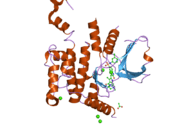STK10
| View/Edit Human | View/Edit Mouse |
Serine/threonine-protein kinase 10 is an enzyme that in humans is encoded by the STK10 gene.[4][5]
This gene encodes a member of the Ste20 family of serine/threonine protein kinases, and is similar to several known polo-like kinase kinases. The protein can associate with and phosphorylate polo-like kinase 1, and overexpression of a kinase-dead version of the protein interferes with normal cell cycle progression. The kinase can also negatively regulate interleukin 2 expression in T-cells via the mitogen activated protein kinase kinase 1 pathway.[5]
References
- ↑ "Drugs that physically interact with Serine/threonine-protein kinase 10 view/edit references on wikidata".
- ↑ "Human PubMed Reference:".
- ↑ "Mouse PubMed Reference:".
- ↑ Kuramochi S, Matsuda Y, Okamoto M, Kitamura F, Yonekawa H, Karasuyama H (Jun 1999). "Molecular cloning of the human gene STK10 encoding lymphocyte-oriented kinase, and comparative chromosomal mapping of the human, mouse, and rat homologues". Immunogenetics. 49 (5): 369–75. doi:10.1007/s002510050509. PMID 10199912.
- 1 2 "Entrez Gene: STK10 serine/threonine kinase 10".
Further reading
- Kuramochi S, Moriguchi T, Kuida K, et al. (1997). "LOK is a novel mouse STE20-like protein kinase that is expressed predominantly in lymphocytes.". J. Biol. Chem. 272 (36): 22679–84. doi:10.1074/jbc.272.36.22679. PMID 9278426.
- Tao L, Wadsworth S, Mercer J, et al. (2002). "Opposing roles of serine/threonine kinases MEKK1 and LOK in regulating the CD28 responsive element in T-cells.". Biochem. J. 363 (Pt 1): 175–82. doi:10.1042/0264-6021:3630175. PMC 1222464
 . PMID 11903060.
. PMID 11903060. - Strausberg RL, Feingold EA, Grouse LH, et al. (2003). "Generation and initial analysis of more than 15,000 full-length human and mouse cDNA sequences.". Proc. Natl. Acad. Sci. U.S.A. 99 (26): 16899–903. doi:10.1073/pnas.242603899. PMC 139241
 . PMID 12477932.
. PMID 12477932. - Walter SA, Cutler RE, Martinez R, et al. (2003). "Stk10, a new member of the polo-like kinase kinase family highly expressed in hematopoietic tissue.". J. Biol. Chem. 278 (20): 18221–8. doi:10.1074/jbc.M212556200. PMID 12639966.
- Ota T, Suzuki Y, Nishikawa T, et al. (2004). "Complete sequencing and characterization of 21,243 full-length human cDNAs.". Nat. Genet. 36 (1): 40–5. doi:10.1038/ng1285. PMID 14702039.
- Beausoleil SA, Jedrychowski M, Schwartz D, et al. (2004). "Large-scale characterization of HeLa cell nuclear phosphoproteins.". Proc. Natl. Acad. Sci. U.S.A. 101 (33): 12130–5. doi:10.1073/pnas.0404720101. PMC 514446
 . PMID 15302935.
. PMID 15302935. - Bignell G, Smith R, Hunter C, et al. (2006). "Sequence analysis of the protein kinase gene family in human testicular germ-cell tumors of adolescents and adults.". Genes Chromosomes Cancer. 45 (1): 42–6. doi:10.1002/gcc.20265. PMID 16175573.
- Kimura K, Wakamatsu A, Suzuki Y, et al. (2006). "Diversification of transcriptional modulation: large-scale identification and characterization of putative alternative promoters of human genes.". Genome Res. 16 (1): 55–65. doi:10.1101/gr.4039406. PMC 1356129
 . PMID 16344560.
. PMID 16344560. - Beausoleil SA, Villén J, Gerber SA, et al. (2006). "A probability-based approach for high-throughput protein phosphorylation analysis and site localization.". Nat. Biotechnol. 24 (10): 1285–92. doi:10.1038/nbt1240. PMID 16964243.
- Wissing J, Jänsch L, Nimtz M, et al. (2007). "Proteomics analysis of protein kinases by target class-selective prefractionation and tandem mass spectrometry.". Mol. Cell Proteomics. 6 (3): 537–47. doi:10.1074/mcp.T600062-MCP200. PMID 17192257.
This article is issued from Wikipedia - version of the 5/25/2016. The text is available under the Creative Commons Attribution/Share Alike but additional terms may apply for the media files.



